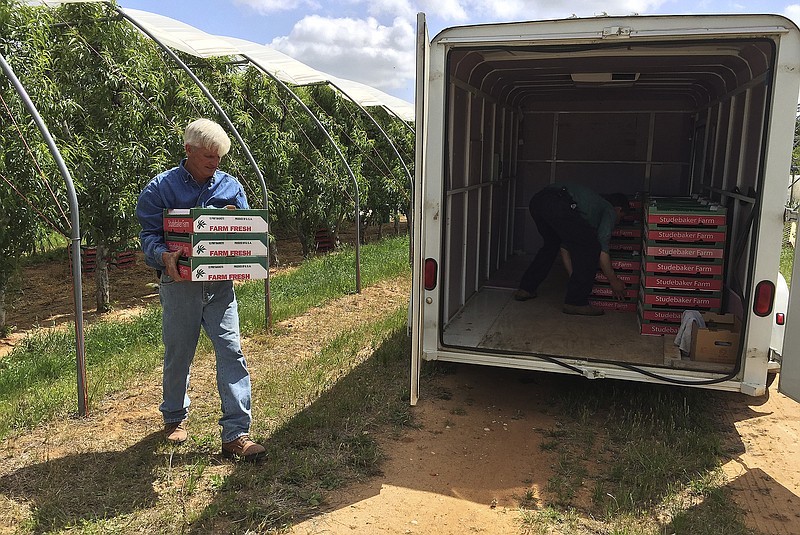SAN ANTONIO (AP) - Winter pretty much stood up South-Central Texas this year, and the neglect is showing in this season's scanty crop of Hill Country peaches.
"Some things bloomed really extended and long, and some didn't take, so it's been really an interesting year," peach grower Russ Studebaker said. "We'll have, I think, about a 30 percent crop, which is better than nothing. So we're happy about that."
The San Antonio Express-News (http://bit.ly/2plMlIQ ) reports lacking an adequate number of "chill hours," most buds didn't get the blasts of cold needed to break out of dormancy. What did bloom into fruit tended to be the earlier varieties, ones nudged along with special treatments or experimental types bred to be "low chill," like the Texas A&M Fire Zest peaches flourishing inside the high tunnels at Studebaker's orchard in Blumenthal. The varieties that tend to be ready later in the summer appear to have taken the season off.
"The lack of chill hours is a big deal," said Larry Stein, extension horticulturalist with Texas A&M AgriLife Research & Extension Center.
Plants that don't get enough chill hours are slow to leaf out, which typically leads to poorly developed fruit or no fruit at all, Stein said in a news release.
How warm was it? Yvette Benavides, a meteorologist at the National Weather Service for Austin-San Antonio, said the average temperature from December through February was 53.6 degrees Fahrenheit, making for the warmest South-Central Texas winter since 1907. The 20th-century winter average for the area is 48.1 degrees Fahrenheit.
Jim Kamas, AgriLife Extension horticulturalist in Fredericksburg, said the winter was the warmest he could remember in 22 growing seasons, providing only 525 of the minimum 800 to 850 chilling hours most trees need to break out of dormancy and properly develop.
"The trees look like it's still winter," he said. "Leaves are still slow to emerge."
Peaches in general will be in higher demand than usual this year, as a mid-March cold blast that missed the Texas orchards hit the ones in Georgia and South Carolina hard.
South Carolina, which has a $90 million annual peach crop and is the largest peach-producing state on the East Coast, lost an estimated 85 percent to 90 percent of its peaches after record low temperatures wiped out early blooms from what had been an unusually warm winter. Strawberry and blueberry producers also saw deep losses.
Officials in Georgia, which ranks third in peach production after California and South Carolina, estimated at least half the peach crop was destroyed in a freeze that cost farmers over $100 million in losses.
"The early spring that we have been experiencing the last few weeks has led to early blooming of our peach crop and unfortunately the freezing temperatures killed any open flowers and possibly compromised emerging buds," Georgia Agriculture Commissioner Gary Black said in a March 15 news release.
The sweet spot may be California, where Roger Duncan, a pomology and viticulture farm adviser based in Modesto, could think of no major problems affecting the southern part of the state's fresh market peach crop.
"I think in general it's probably going to be just fine," he said.
Although that's good news for peach lovers, it may not be enough to comfort fans of Hill Country peaches.
Texas may be a small player in the grand scheme - its 9 million pounds of peaches in 2016 was dwarfed by California's 1.2 billion pounds, South Carolina's 136 million pounds and even Georgia's 86 million pounds - but Hill Country producers boast that their elevation and soils replete with mineral deposits from ancient seas make for the most flavorful peaches around.
The area's peach growers have built a niche market on that flavor. While some sell to regional farmers' markets, most do a brisk business just letting customers come to them. During the late spring and summer months, stands selling peaches, pies, cobblers and preserves spring up in Fredericksburg and east along U.S. 290 to Stonewall and as far as Johnson City.
The Stonewall Peach JAMboree and Rodeo, which this year runs June 16 and 17, celebrates Stonewall as the self-declared "Peach Capital of Texas," with activities including a peach-eating contest and the coronation of the peach queen.
Jamey Vogel, a grower who is president of the Hill Country Fruit Council, said the best advice for Hill Country peach fans is to check the council's website and plan their visits early in the season, as the outlook isn't good for varieties that usually come out in late June, July and August.
"Our crop is not as strong as our last three pretty good crops," he said. "Our early stuff is pretty strong; there should be enough to meet most of the retail demands. The later stuff, we'll have to do with what we have."
Ricky Priess of Gold Orchards in Stonewall was even less optimistic, saying that while he'd have plenty of vegetables, homemade peach ice cream, and peach pies, cobblers, breads and preserves to sell, he wasn't sure he'd be able to muster up enough peaches for customers to tote home this summer.
"I don't know if we'll have any to sell," he said. "I'll just have to see how they turn out. I know I was hoping there was going to be a few more, but it doesn't look like they're really growing."
___
Information from: San Antonio Express-News, http://www.mysanantonio.com
